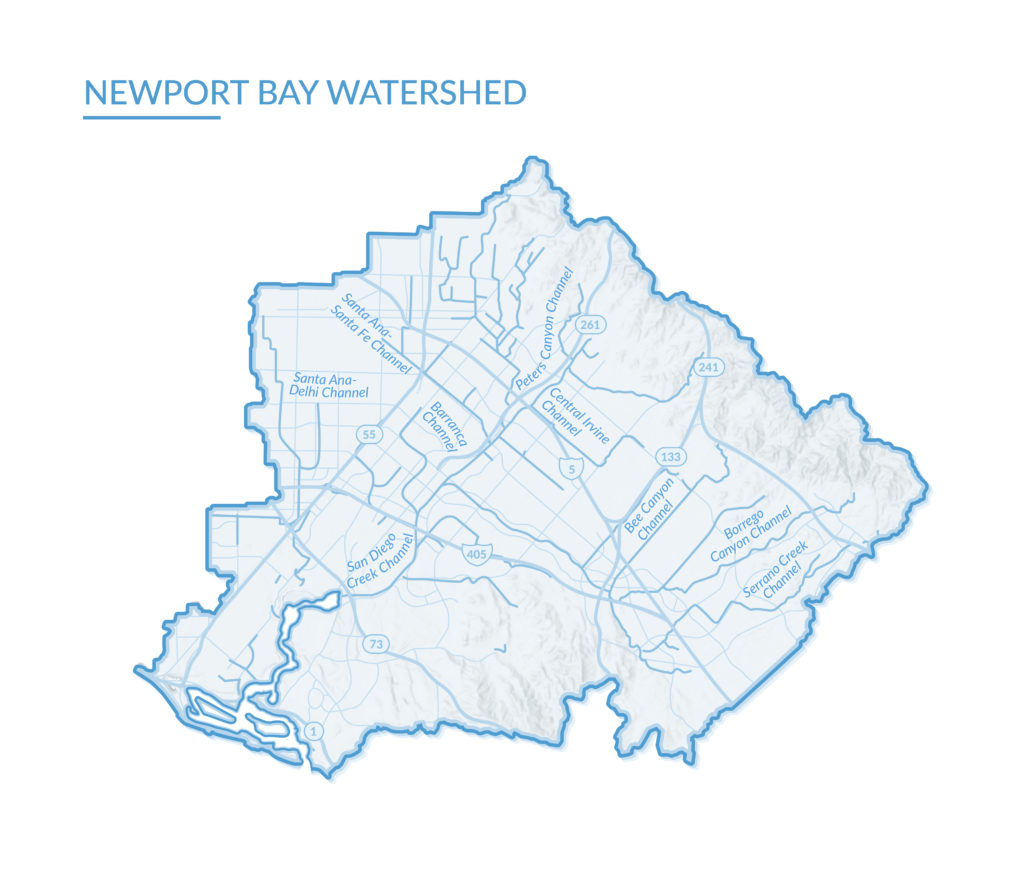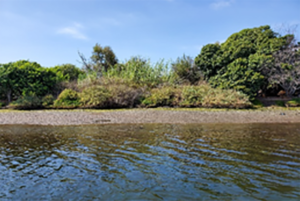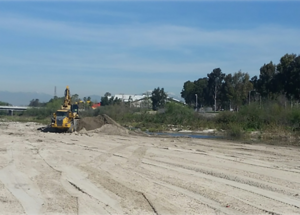Watershed Appreciation – Get to Know the Newport Bay Watershed
June 8, 2021

Whether you are jogging in Peters Canyon Regional Park or biking the San Diego Creek Trail, you are enjoying the Newport Bay Watershed’s resources. When in this watershed, actions you take can help improve the water quality in Orange County’s rivers, lakes, bays, and ocean. From unique features and recreational areas, to pollution prevention, it’s time to take a deep dive and get to know the Newport Bay Watershed.
The Newport Bay Watershed is the second in a series of blogs that will showcase the wonders of each of the 11 watersheds in Orange County. If you’re new to the concept of watershed appreciation, our What is A Watershed? page is a great place to get started! To find out which watershed you live in, visit our interactive map.
A watershed is the land area that channels stormwater and urban runoff to creeks, streams, rivers, and eventually to lakes, reservoirs, bays, and the ocean. Runoff from homes and businesses travels untreated through our watersheds and can contain pollution that degrades all waterways. So remember, everyday actions can have watershed level effects, and wherever you are within Orange County’s 948 square miles – you are in a watershed.
Wonders of the Newport Bay Watershed
Unique Features
The Newport Bay Watershed covers 154 square miles, including all or parts of the cities of Costa Mesa, Irvine, Laguna Hills, Laguna Woods, Lake Forest, Newport Beach, Orange, Santa Ana, and Tustin. Upper Newport Bay, locally known as Back Bay, is one of the largest natural estuaries in Southern California. Comprised of approximately 1,000 acres of open space, it encompasses nature preserves, bluffs and a diverse ecosystem. With only 5 percent of the state’s coastal wetlands remaining, preservation of Newport Bay has been and will remain a priority for Orange County.
Wildlife & Plants
The Newport Bay Watershed is teeming with biodiversity: from microscopic plankton to large predators. Two hundred species of birds have been documented with some 30,000 migratory birds seen on any given day in the winter. The endangered Ridgway’s Rail and California Least Tern nest here during the spring and summer months. Coyotes, bobcats and racoons keep the small rodent population in balance while numerous amphibians and reptiles do the same for the aquatic insects along the freshwater areas. In undeveloped areas of the watershed you can find grassland, coastal sage scrub, and riparian habitats where smaller amphibians, mammals and reptiles abound. Cooper’s, red-tail, and re-shouldered hawks can also be seen surveying these areas for their next meal.
Recreational Areas
In addition to providing key habitats for a variety of wildlife, the Newport Bay Watershed supports a variety of recreational activities, including hiking, biking, kayaking, swimming, and many others. Here are a few of the many recreational areas supported by the Newport Bay Watershed.
- Upper Newport Bay is among the finest locations in Orange County for recreation and wildlife viewing, serving as a hub for birders, joggers, bicyclists, hikers, and horseback riders. Lower Newport Bay is home to the bayside beaches and is one of the largest small boat harbors in the country. This is a favorite weekend destination for visitors and residents alike.
- Peters Canyon Regional Park has a variety of trails great for hiking, biking, and even horseback riding. Along the trails visitors will encounter various habitats and wildlife including mule deer, reptiles, and amphibians. Dogs are permitted on leash but be sure to pick up their waste and dispose of it in a trash can.
- The San Diego Creek Trail is a great place for bicycle lovers and joggers to explore the watershed. With over 14 miles of trail, you’ll easily get from one place to another, including parks, shopping, neighborhoods, and schools.
Water Quality
Here in Orange County, water that enters the storm drain system is not treated before it flows to our waterways. Pollutants can be carried from all across the watershed to our waterways, ultimately ending up in Newport Bay. For many of us the most obvious stormwater pollutants are those we can see: trash, plastics, engine oil, or pet waste. However, in the Newport Bay Watershed, priority pollutants include sediment (dirt or soil) and nutrients (fertilizers) which may be more difficult to spot with the naked eye. Sediment that is picked up by runoff can clog storm drains, causing localized flooding, filling in of waterways, and other ecological problems. Excessive nutrients impact aquatic and human health through the process of eutrophication, which creates algal blooms that starve aquatic life of oxygen.
Healthy Watersheds Support Healthy Communities
Thirty years ago, Upper Newport Bay was at risk of becoming, well, not a bay. It was filling in with excessive sediment from sources such as agriculture, construction, and channel erosion. In 1998, sediment loading limits were set and regular dredging mandated by the Santa Ana Regional Water Quality Control Board to ensure bay waters ran deep and the bay could accommodate rainy season floods.
Newport Bay Watershed Successes:
The award-winning Upper Newport Bay Ecosystem Restoration project was completed in 2010 by the U.S. Army Corps of Engineers, the County of Orange, the California Department of Fish & Wildlife, and the California Coastal Conservancy, along with the City of Newport Beach, the U.S. Fish & Wildlife Service and the National Marine Fisheries Service as major stakeholders. The project improved estuarine habitats, increased tidal circulation, and reduced predator access to sensitive habitats and endangered birds by deepening and expanding storage basins within Upper Newport Bay, reducing the need for frequent dredging. Separately from restoration efforts, Newport Bay is subject to pollutant-specific water quality management programs and has undergone extensive research and ongoing work to maintain a healthy watershed that meets federal and state standards. The following are a few key highlights of collaborative efforts in achieving water quality regulatory targets led and funded by the County, watershed cities, the Irvine Company, and the Irvine Ranch Water District to name a few:
- Newport Bay supports a rich wildlife population with marine aquatic habitats, mudflats, salt marshes, and bird nesting islands, which are particularly sensitive to over-sedimentation. Collaborative stakeholder efforts resulted in stabilized channels and reduced sediment concentrations. Monitoring data show suspended sediment loading to Upper Newport Bay and the watershed have been greatly reduced over the years and regulatory targets and goals are being met. The Upper Newport Bay has never looked better as eelgrass continues to grow in abundance.
- A large-scale sediment removal project within San Diego Creek in 2019 restored flood control capacity and limited the transportability of sediments from open space areas further helping to reduce sediment loading to Newport Bay.
- Newport Bay experienced significant seasonal algal blooms beginning in the 1980s, but the change in landscape over time from irrigated agriculture to urban land use resulted in reductions in nutrient runoff. The Algal biomass from nutrient and sediment pollution has been undetected at County monitoring stations used to assess management impacts in the Newport Bay mudflat since 2012.


- The Irvine Ranch Water District’s extensive Natural Treatment System, including the San Joaquin Marsh, has been developed to remove pollutants found in urban runoff throughout the watershed before they reach Upper Newport Bay.

Protecting our Newport Bay Watershed
In addition to the improvements and monitoring programs described above, H2OC provides resources to residents and businesses on how to prevent water pollution and encourages personal action by working with members of the OC community to prevent harmful runoff from entering our waterways. How can OC residents help keep these successes going? You’d be surprised at how many small acts generate big results:
Minimize Nutrients from Fertilizers
- Apply fertilizer sparingly, and only in accordance with label instructions.
- Use mulch to reduce the need for fertilizer.
- Do not apply fertilizer within 48 hours of forecasted rain.
- Use only fertilizer, not combination weed and feed products.
Prevent Erosion to Prevent Sediment Pollution
- Plant ground cover over areas of bare soil.
- Cover stockpiles of dirt with tarps when landscaping.
- Use straw wattles on slopes to contain soil and prevent erosion.
- Direct downspouts from roof gutters to landscaped areas or into a rain barrel.
More Ways to Appreciate Orange County’s Watersheds
There are many ways to get involved in your community and appreciate your local watershed.
Explore your watershed and report water pollution. Explore Orange County’s creeks, trails, and coastline and make observations about water quality conditions. If you see anything abnormal (such as dead fish, oil spills, leaking barrels, or other signs of pollution), visit our Report Pollution page to report the problem.
Connect with area watershed organizations through local events. Join H2OC, other organizations, and your neighbors who are working to protect and restore our creeks, rivers, bays, and ocean. Find events in your area.
Spread the word. To protect our waterways, share your knowledge about preventing water pollution and encourage others to do the same. You can even involve your kids in learning about watersheds and pollution prevention through our kids’ Watershed Activity Workbook.
Learn more. It’s our goal to create quality content that educates the Orange County community about runoff pollution. Follow us on Facebook and Instagram to stay in the know. For more information on watersheds, view our What is a Watershed? page and our Tips for Protecting Your Watershed brochure.
To learn more about the Newport Bay Watershed, click here.